натура — Викисловарь
Морфологические и синтаксические свойства
на-ту́-ра
Существительное, неодушевлённое, женский род, 1-е склонение (тип склонения 1a по классификации А. А. Зализняка).
Корень: -натур-; окончание: -а [Тихонов, 1996].
Произношение
Семантические свойства
Значение
- устар., шутл. то же, что природа [≈ 1][≠ 1][▲ 1][▼ 1] ◆ Отсутствует пример употребления (см. рекомендации).
- характер, нрав, темперамент, совокупность свойств, а также человек, носитель этих свойств [≈ 2][≠ 2][▲ 2][▼ 2] ◆ Бенедикт Сарнов так пишет о Свирском: «Главным свойством этого неуживчивого характера, я бы сказал, первопричиной этой неуживчивости была не какая-нибудь там склочность его натуры, а основополагающая черта его личности, для обозначения которой я не могу подобрать никакого другого слова, кроме старомодного, уже почти вышедшего из употребления: донкихотство». «Пять книг недели», 8 июня 2006 г. // «Независимая газета — Приложение „НГ-Ex Libris“» (цитата из Национального корпуса русского языка, см. Список литературы)
- разг. организм (человека, животного) [≈ 3][≠ 3][▲ 3][▼ 3] ◆ Отсутствует пример употребления (см. рекомендации).
- то, что реально существует; действительность [≈ 4][≠ 4][▲ 4][▼ 4] ◆ Отсутствует пример употребления (см. рекомендации).
- искусств. природный, живой образец для изображения в художественном произведении [≈ 5][≠ 5][▲ 5][▼ 5] ◆ Отсутствует пример употребления (см. рекомендации).
- экон. товары, продукты и т. п. как платёжное средство взамен денег [≈ 6][≠ 6][▲ 6][▼ 6] ◆ Отсутствует пример употребления (см. рекомендации).
Синонимы
Антонимы
Гиперонимы
Гипонимы
Родственные слова
Этимология
Происходит от лат. natūra «рождение, миропорядок, природа», из nasci «рождаться, происходить». Восходит к архаичн. *gnascor, родств. gigno «рождать». Впервые в белор. переводе Тристана (ХVI в.) и у Котошихина. Заимств., вероятно, через польск. Ср. также: русск. природа образовано из при- и род. Использованы данные словаря М. Фасмера. См. Список литературы.Фразеологизмы и устойчивые сочетания
Перевод
| то, что реально существует; действительность | |
| природный, живой образец для изображения | |
| товары, продукты и т. п. как платёжное средство взамен денег | |
Анаграммы
Библиография
Значение слова НАТУРА. Что такое НАТУРА?
НАТУ́РА, -ы, ж.
1. Устар. То же, что природа (в 1 знач.).
2. Устар. Сущность, основное свойство кого-, чего-л. Натура мысли состоит в том, чтобы стремиться к истине. Чернышевский, <Полемика между «Русским вестником» и «Молвою»>.
3. Характер, нрав, темперамент. — Ну, извините-с, такая у меня натура, не могу лицемерить. Чехов, Отец семейства. Купец Смельков, по определению товарища прокурора, был тип могучего, нетронутого русского человека с его широкой натурой. Л. Толстой, Воскресение. Торопиться было не в его натуре: к чему? и куда именно? и зачем? Сергеев-Ценский, Блистательная жизнь. | с определением. О человеке. Молодой человек был болезненная, экстазная, бедно развитая натура, бледный мечтатель, чахлый и испитой человечек. Достоевский, Братья Карамазовы. — [Зина] натура свободная, смелая.
Чехов, Соседи. || Разг. Организм (человека, животного). — Я, брат, как поем, непременно поспать должен. Натура требует — и я не противлюсь. Тургенев, Вешние воды. Через шесть дней моя крепкая натура, с помощью хинина и настоя подорожника, победила болезнь. Куприн, Олеся.4. То, что реально существует; действительность. [Никандр Порфирьич] допоздна рисовал акварелью морские виды (хотя в натуре моря никогда не видел). Сергеев-Ценский, Недра. В газетах, конечно, писали и об экскаваторах, и о подъемниках —. Но одно дело — слова, другое дело — натура. Кочетов, Журбины.
5. Иск. Природный, живой образец, с которого рисуют, делают съемку и т. п. Рисовать с натуры. □ Лучшими его собеседниками были холст, краски и натура: березки, закаты, река. Полторацкий, В родных краях. || Иск. Натурщик, натурщица. Другой натурщицы не было, и я решился — писать лицо без натуры, из головы, «от себя», как говорят художники.
6. Товары, продукты и т. п. как платежное средство взамен денег. За обучение — она деньгами не брала, а предоставляла благодарить ее натурой. Таким образом, у нее был обеспеченный запас муки, пряжи, полотна. Салтыков-Щедрин, Мелочи жизни. — Жил он у меня на одних только харчах 408 и жалованье натурой получал: крупой, мясом, солью. Чехов, В приюте для неизлечимобольных и престарелых.
◊
В натуре вещей ( устар.) — то же, что в природе вещей ( см. природа). — Ну, да, конечно, это все в натуре вещей, — промолвил Василий Иваныч. Тургенев, Отцы и дети. Вторая натура — о чем-л. составляющем основную черту, свойство данного человека.[Лат. natura]
kartaslov.ru
натура — это… Что такое натура?
1. Особенности человеческого организма.
Бодрая, железная (разг.), живучая, жизнестойкая, закаленная, здоровая, крепкая, крестьянская, могучая, мощная, неутомимая, рыхлая, сильная, слабая, стойкая, хлипкая (разг.). Жидкостная, немецкая.
2. Характер, темперамент человека.
О сильном, волевом характере, эмоциональном темпераменте; о широкой, сложной натуре.
Активная, анархическая, беспокойная, бесстрашная, богатая, бодрая, боевая, взбалмошная (разг.), властная, властолюбивая, волевая, восприимчивая, впечатлительная, героическая, гибкая, глубокая, горячая, деспотическая, дикая, домостроевская, живая, жизнерадостная, загадочная, запутанная, исключительная, ищущая, кипучая, крепкая, могучая, мощная, мужественная, мятежная, настойчивая, недюжинная, независимая, неистовая, необузданная, непонятная, непоседливая, нервическая (устар.), нервная, несгибаемая, неугомонная, неукротимая, неуравновешенная, неутомимая, общительная, одаренная, оптимистическая, отзывчивая, пламенная, подвижная, порывистая, пылкая, разносторонняя, редкая, решительная, русская, самобытная, самостоятельная, свободная, сдержанная, славянская, сильная, сложная, смелая, стойкая, страстная, сумасбродная, твердая, темпераментная, титаническая, требовательная, увлекающаяся, упрямая, фанатическая, фанатичная, цельная, цыганская, чувственная, чувствительная, широкая, экзальтированная, экстатическая, экстравагантная, эксцентрическая, эмоциональная, энергическая (устар.), энергичная, южная.
О вялом, замкнутом характере; о слабой, флегматичной натуре.
Апатическая, апатичная, безвольная, вялая, гнилая, замкнутая, инертная, ледяная, ленивая, малодушная, мертвенная, мечтательная, мягкая, неглубокая, необщительная, неэмоциональная, податливая, подчиненная, рабская, рефлектирующая, робкая, рыхлая, слабая, созерцательная, спокойная, сухая, тупая, уединенная (устар.), флегматическая, флегматичная, холодная.О моральной оценке натуры человека.
Бездушная, бескорыстная, благородная, великодушная, волчья, двойственная, двуличная, деликатная, грубая, дубовая, душевная, едкая, желчная, зверская, иезуитская, искренняя, испорченная, кляузная, коварная, лукавая, мелкая, мелочная, мещанская, мягкая, неиспорченная, нетронутая, нечестная, низменная, отзывчивая, открытая, первобытная, плоская, подлая, подозрительная, пошлая, правдивая, предательская, прекрасная, простая, простецкая (разг.), простосердечная, прямая, прямолинейная, раздражительная, святая (устар.), себялюбивая, склочная (простореч), сутяжная, тщеславная, узкая, хищная, человечная, черствая, честная, честолюбивая, чистая, чуткая, щедрая, щепетильная, эгоистическая, эгоистичная.
Об одаренной, утонченной натуре.
Аристократическая, артистическая, возвышенная, впечатлительная, гениальная, избранная, изысканная, изящная, музыкальная, одаренная, поэтическая, рафинированная, талантливая, творческая, тонкая, утонченная, художественная, художническая (устар.), чуткая, эстетическая. Бурлацкая, гладиаторская, гуртовая, заячья, изломанная, кремневая, мефистофельская, огненная, расхлябанная, рыбья, самовоспитанная, телячья, тряпичная.
Словарь эпитетов русского языка. 2006.
epithets.academic.ru
Nature — Вікіпедія
Матеріал з Вікіпедії — вільної енциклопедії.
Nature («Нейче», з англ. — «Природа») — найпрестижніший науковий рецензований журнал світу. У 2009 році увійшов до Списку 100 найвпливовіших журналів з біології і медицини за останні 100 років під № 1 і був названий Журналом Сторіччя. [1]
Друкується щотижня у Сполученому королівстві, починаючи з 1869 року. Nature друкує статті з усіх областей досліджень. Видавництво — Nature Publishing Group.
Публікації в таких журналах, як Nature або Science, вкрай престижні, через те що статті надруковані в цих віданнях частіше цитуються, а автор отримує широку популярність і за межами своєї галузі науки. Так, імпакт-фактор Nature в 2009 році дорівнював 34,48, тобто кожна стаття за два роки, що пройшли після публікації, в середньому цитується більше 34-х разів.
Критерії відбору статей в Nature (як і в Science) надзвичайно жорсткі. Велика кількість статей відсіваються ще до стадії рецензування, оскільки результати досліджень, описані у пропонованій до публікації в Nature статті, повинні представляти вельми істотне просування в тій чи іншій галузі науки.
Так, саме в Nature були опубліковані статті:
- Про відкриття рентгенівських променів (WC Röntgen. On a new kind of rays. / / Nature. — 1896. — Т. 53. — № 1369. — С. 274—276.)
- Про експериментальне виявлення хвильової природи електрона (C. Davisson and LH Germer. The scattering of electrons by a single crystal of nickel. Nature, 119 (1927) 558—560).
- Про відкриття нейтрона (J. Chadwick. Possible existence of a neutron. Nature, 129 (1932) 312).
- Про відкриття ділення атомного ядра (L. Meitner, OR Frisch. Disintegration of uranium by neutrons: a new type of nuclear reaction. Nature, 143 (1939) 239—240).
- Про відкриття спіральної структури ДНК (JD Watson and FHC Crick. Molecular structure of Nucleic Acids: A structure for deoxyribose nucleic acid. Nature, 171 (1953) 737—738).
- Про виявлення озонової діри над Антарктикою (JC Farman, BG Gardiner and JD Shanklin. Large losses of total ozone in Antarctica reveal seasonal ClOx / NOx interaction. Nature, 315 (1985) 207—210).
- Про перше клонування ссавця (вівця Доллі) (I. Wilmut, AE Schnieke, J. McWhir, AJ Kind and KHSCampbell. Viable offspring derived from fetal and adult mammalian cells. Nature, 385 (1997) 810—813).
- Про розшифрування людського генома (International Human Genome Sequencing Consortium. Initial sequencing and analysis of the human genome // Nature. — 2001. — Т. 409. — № 6822. — С. 860—921.).
uk.wikipedia.org
натуральный — Викисловарь
Морфологические и синтаксические свойства
| падеж | ед. ч. | мн. ч. | |||
|---|---|---|---|---|---|
| муж. р. | ср. р. | жен. р. | |||
| Им. | натура́льный | натура́льное | натура́льная | натура́льные | |
| Рд. | натура́льного | натура́льного | натура́льной | натура́льных | |
| Дт. | натура́льному | натура́льному | натура́льной | натура́льным | |
| Вн. | одуш. | натура́льного | натура́льное | натура́льную | натура́льных |
| неод. | натура́льный | натура́льные | |||
| Тв. | натура́льным | натура́льным | натура́льной натура́льною | натура́льными | |
| Пр. | натура́льном | натура́льном | натура́льной | натура́льных | |
| Кратк. форма | натура́лен | натура́льно | натура́льна | натура́льны | |
на-ту-ра́ль-ный
Прилагательное, относительное и качественное, тип склонения по классификации А. Зализняка — 1*a. Сравнительная степень — натура́льнее.
Корень: -натур-; суффикс: -альн; окончание: -ый [Тихонов, 1996].
Произношение
- МФА: [nətʊˈralʲnɨɪ̯]
Семантические свойства
 Натуральное [1] дерево
Натуральное [1] деревоЗначение
- природный, естественный, в противоположность искусственному ◆ Основным компонентом натурального каучука является полиизопрен. ◆ Эту мебель изготавливают исключительно из традиционных материалов, как правило, из натурального дерева или шпона темных тонов (дуб, вишня), украшают инкрустацией, мозаикой из шпона различных видов древесины, ручной резьбой, золотым тиснением и даже стразами Svarovski. Елена Давыдова, «Классики и современники», 2003 г. // «Карьера» (цитата из Национального корпуса русского языка, см. Список литературы)
- действительный, подлинный, соответствующий действительности, природе вещей ◆ Деталь изображена в натуральную величину.
- разг. полностью подобный чему-либо или кому-либо ◆ Комната — натуральное общежитие, и я ещё подумал: неужели хочется людям из своих благоустроенных квартир ехать сюда? В. А. Солоухин, «Терновник»
- экон. основанный на товарном обмене, не использующий денежных отношений ◆ Отсутствует пример употребления (см. рекомендации).
- матем. относящийся к множеству положительных целых чисел ◆ Существует бесконечное множество натуральных чисел — для любого натурального числа найдется другое натуральное число, большее его.
- матем. о логарифме — имеющий в качестве основания число Эйлера ◆ Отсутствует пример употребления (см. рекомендации).
- муз. о ладе — чистый, не имеющий отклонений, в противоположность гармоническому или мелодическому ◆ Лад, построенный на интервалах: тон-полутон-тон-тон-полутон-тон-тон, называется натуральным минором.
Синонимы
- природный, естественный
- частичн.: действительный, настоящий, подлинный, реальный
- товарный
- —
- неперовский
Антонимы
- искусственный, деланый, синтетический
- изменённый, искажённый
- дробный
Гиперонимы
Гипонимы
Родственные слова
| Список всех слов с корнем «-натур-» | ||
| ||
Этимология
Происходит от лат. nātūrālis «естественный, родной, врождённый». Русск. натуральный — начиная с Ф. Прокоповича. Заимств. через польск. naturalny.Использованы данные словаря М. Фасмера. См. Список литературы.
Фразеологизмы и устойчивые сочетания
Перевод
| связанный с целыми числами | |
ru.wiktionary.org
Nature reserve — Wikipedia
Protected area for flora, fauna or features of geological interest
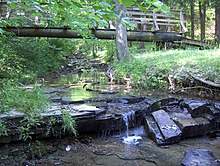
A nature reserve may also be known as a natural reserve, wildlife refuge or sanctuary, biosphere reserve (bioreserve), natural or nature preserve, or nature conservation area. It is a protected area of importance for flora, fauna, or features of geological or other special interest, which is reserved and managed for purposes of conservation and to provide special opportunities for study or research. Nature reserves may be designated by government institutions in some countries, or by private landowners, such as charities, and research institutions. Nature reserves fall into different IUCN categories depending on the level of protection afforded by local laws. Normally it is more strictly protected than a nature park. Various jurisdictions may use other terminology, such as ecological protection area or private protected area in legislation and in reserves’ official names.
History[edit]
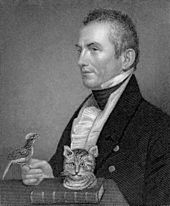
Cultural practices that roughly equate to the establishment and maintenance of reserved areas for animals date back to antiquity, with King Tissa of Ceylon establishing one of the world’s earliest wildlife sanctuaries in the 3rd century BC.[1] Early reservations often had a religious underpinning, such as the ‘evil forest’ areas of West Africa which were forbidden to humans, who were threatened with spiritual attack if they went there. Sacred areas taboo from human entry to fishing and hunting are known by many ancient cultures worldwide.[2]
The world’s first modern nature reserve was established in 1821 by the naturalist and explorer Charles Waterton around his estate in Walton Hall, West Yorkshire. He spent £9000 on the construction of a three mile long, 9 ft tall wall to enclose his park against poachers.[3] He tried to encourage bird life by planting trees and hollowing out trunks for owls to nest in.
Waterton invented artificial nest boxes to house starlings, jackdaws and sand martins; and unsuccessfully attempted to introduce little owls from Italy.[4] Waterton allowed local people access to his reserve and was described by David Attenborough as “one of the first people anywhere to recognise not only that the natural world was of great importance but that it needed protection as humanity made more and more demands on it”.[5]
Drachenfels (Siebengebirge) was protected as the first state-designated nature reserve in modern-day Germany; the site was bought by the Prussian State in 1836 to protect it from further quarrying.
The first major nature reserve was Yellowstone National Park in Wyoming, United States, followed by the Royal National Park near Sydney, Australia and the Barguzin Nature Reserve of Imperial Russia, the first of zapovedniks set up by a federal government entirely for the scientific study of nature.[6]
Around the world[edit]
Today there are several national and international organizations that have taken the responsibility of supervising numerous systems of non-profit animal sanctuaries and refuges in order to provide a general system for sanctuaries to follow. Among them, the American Sanctuary Association monitors and aids in various facilities to care for exotic wildlife. Their accredited facilities follow high standards and a rigid application processes to ensure that the animals under their care are avidly cared for and maintained. The number of sanctuaries has substantially increased over the past few years.[citation needed]
Australia[edit]
In Australia, a nature reserve is the title of a type of protected area used in the jurisdictions of the Australian Capital Territory, New South Wales, Tasmania and Western Australia. The term “nature reserve” is defined in the relevant statutes used in those states and territories rather than by a single national statute. As of 2016, 1767 out of a total of 11044 protected areas listed within the Australian National Reserve System used the term «nature reserve» in their names.[7]
Brazil[edit]
In Brazil, nature reserves are classified as ecological stations (Portuguese: )estações ecológicas) or biological reserves (Portuguese: reservas biológicas) by the National System of Conservation Units. Their main objectives are preserving fauna and flora and other natural attributes, excluding direct human interference. Visits are allowed only with permission, and only for educational or scientific purposes. Changes to the ecosystems in both types of reserve are allowed to restore and preserve the natural balance, biological diversity and natural ecological processes.[8] Ecological stations are also allowed to change the environment within strictly defined limits (e.g. affecting no more than 3% of the area or 1,500 hectares (3,700 acres), whichever is less) for the purpose of scientific research.[9] A wildlife reserve in Brazil is also protected, and hunting is not allowed, but products and by-products from research may be sold.[8]
The wildlife refuge in Brazil has as its objective protecting natural flora and fauna where conditions are assured for the existence and reproduction of species or communities of the local flora and the resident or migratory fauna. It can be constituted by private areas, as long as it is possible to make compatible the objectives of the unit with the utilization of the land of the natural resources of the location by the landowners. Public visitation is subject to the conditions and restrictions established by the management plan of the unit and to the regulations established by the body most important for its administration and scientific research depends on previous authorization from the body responsible for the administration of the unit and is subject to the conditions and restrictions established by this body.[10]
Canada[edit]
In Canada, UNESCO has recognized 18 nature reserves, mostly along the Niagara Escarpment and St. Lawrence River in Ontario.[11]
Federally, Canada recognizes 55 National Wildlife Areas across the country, containing species of ecological significance. The relevant Ministry is known as Environment and Climate Change Canada, which protects these areas under legislation known as the Canada Wildlife Act. The areas comprise approximately 1 million hectares of habitat, half of which is marine habitat, for the purpose of conservation and research.[12]
Many conservation groups protect nature reserves in Canada as well, including Nature Conservancy Canada, Ducks Unlimited, and Escarpment Biosphere Conservancy. These charities operate to protect wilderness on privately owned lands, including through Canada’s Ecological Gifts Program.[13]
Egypt[edit]
There are 30 nature reserves in Egypt which cover 12% of Egyptian land. Those nature reserves were built according to the laws no. 102/1983 and 4/1994 for protection of the Egyptian nature reserve. Egypt announced a plan from to build 40 nature reserves from 1997 to 2017, to help protect the natural resources and the culture and history of those areas. The largest nature reserve in Egypt is Gebel Elba (35,600 square kilometres (13,700 sq mi)) in the southeast, on the Red Sea coast.
European Union[edit]
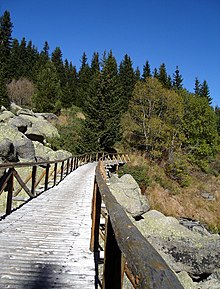
Denmark[edit]
Denmark has three national parks and several nature reserves, some of them inside the national park areas. The largest single reserve is Hanstholm Nature Reserve, which covers 40 km2 (9,900 acres) and is part of Thy National Park.
Sweden[edit]
In Sweden, there are 29 national parks. The first of them was established in 1909. In fact, Sweden was the first European country that established 9 national parks.[14] There are almost 4,000 nature reserves in Sweden. They comprise about 85% of the surface that is protected by the Swedish Environmental Code.[15]
Estonia[edit]
In Estonia, there are 5 national parks, more than 100 nature reserves, and around 130 landscape protection areas. The largest nature reserve in Estonia is Alam-Pedja Nature Reserve, which covers 342 km2 (85,000 acres).
France[edit]
As of 2017, France counts 10 national parks, around 50 regional nature parks, and 8 marine parks.
Germany[edit]
In 1995 Germany had 5,314 nature reserves (German: Naturschutzgebiete) covering 6,845 km2 (2,643 sq mi), the largest total areas being in Bavaria with 1,416 km2 (547 sq mi) and Lower Saxony with 1,275 km2 (492 sq mi).
Hungary[edit]
In Hungary, there are 10 national parks, more than 15 nature reserves and more than 250 protected areas. Hortobágy National Park is the largest continuous natural grassland in Europe and the oldest national park in Hungary. It is situated on the eastern part of Hungary, on the plain of the Alföld. It was established in 1972. There are alkaline grasslands interrupted by marshes. They have a sizable importance because there are the fishponds. One of the most spectacular sights of the park is the autumn migration of cranes. Some famous Hungarian animal species live in Hortobágy National Park, such as the grey cattle, racka long-wool sheep living only in Hungary, Hungarian horses and buffalo. Hortobágy National Park has been a UNESCO World Heritage Site since 1 December 1999.
Poland[edit]
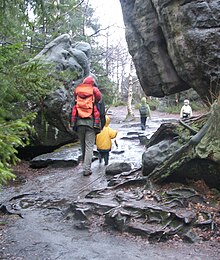
As of 2011, Poland has 1469 nature reserves.[16]
Portugal[edit]
Nature reserves are one of the 11 types of protected areas in Portugal. As of 2012, Portugal had a total of 46 protected areas, which represented 6,807.89 km2 (2,628.54 sq mi) of land and 463.94 km2 (179.13 sq mi) of marine surfaces. Among the protected areas, nine are classified as nature reserve (Portuguese: reserva natural).[17][18]
Romania[edit]
About 5.18% of the area of Romania has a protected status (12,360 km²), including the Danube Delta, which makes up half of this area (2.43% of Romania’s total area).
Switzerland[edit]
The Swiss National Park, created in 1914, was one of the earliest national parks in Europe. In addition to the Swiss National Park, Switzerland also has sixteen regional nature parks.[19]
The environmental organization Pro Natura takes care of about 650 nature reserves of various sizes throughout Switzerland (250 square kilometers).
Israel[edit]
Israel’s National parks of Israel are declared historic sites or nature reserves, which are mostly operated and maintained by the National Nature and Parks Authority. As of 2019, Israel maintains more than 490 nature reserves that protect 2,500 species of indigenous wild plants, 20 species of fish, 530 species of birds and 70 species of mammals. Total, they cover (6,400 square kilometres (2,500 sq mi)) of nature reserves, approximately 28% of Israel land. In 1984, the two areas with the highest number of nature reserves were the South (15.2%) and Samaria (the Shomron, 13.5%).[20]
Japan[edit]
Under the Nature Conservation Law, places can be designated as ‘wilderness areas’, ‘nature conservation areas’ and ‘prefectural nature conservation areas’. In 1995, when the Japanese Government published its information in English, there were 5 wildernesses, 10 nature conservation areas and 516 prefectural nature conservation areas.[21]
Jordan[edit]
There are seven nature reserves in Jordan. In 1966 the organization that would later start Jordan’s nature reserves, the Royal Society for the Conservation of Nature, was founded. RSCN’s first efforts involved bringing back severely endangered species. In 1973, RSCN was given the right to issue hunting licenses, giving RSCN an upper hand in preventing extinction. The first step was the founding of Jordan’s first nature reserve, Shaumari Wildlife Reserve, in 1975. The primary purpose was to create means to breed endangered species, specifically: the Arabian oryx, gazelles, ostriches, and Persian onagers in their natural environment.
Kyrgyzstan[edit]
By the end of 2009 there were 10 nature reserves (Kyrgyz: корук, koruk) in Kyrgyzstan covering 600,000 hectares (6,000 km2) or about 3% of the total area of the country.
New Zealand[edit]
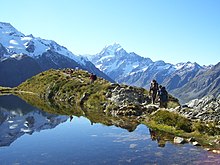
New Zealand has a variety of types of reserve, including national parks, various types of conservation areas (including stewardship land that is yet to be officially classified), and seven specific types of «reserve», each of which prioritize various degrees of protection to different amenities such as scenery, recreation, flora and fauna, scientific value, or history. Land is often sub-categorised beneath its general classification, as defined in law between the Reserves Act of 1977, the National Parks Act of 1980, and the Conservation Act of 1987. Under these classifications, the Department of Conservation administers more than 80,000 km2—nearly 30 percent of the nation’s total area—with at least some degree of protection. This land is composed of 14 National Parks, 30 Conservation Parks, and approximately 8,900 discrete areas of land in total.
Although the most public land is strongly protected for natural preservation, the term nature reserve is specifically defined in the Reserves Act to mean a reserve that prioritizes the protection of rare flora and fauna, to the extent that public access is by permit only. Some of these reserves include Ecological Islands, a comparatively new concept in wildlife preservation, pioneered in New Zealand to help re-build the populations of nearly extinct birds, and other species that are heavily threatened by introduced predators.
Nicaragua[edit]
Peñas Blancas, part of the Bosawás Biosphere Reserve is the second largest rainforest in the Western Hemisphere, after the Amazonian Rainforest in Brazil. Located northeast of the city of Jinotega in Northeastern Nicaragua.In Nicaragua, the Ministry of the Environment and Natural Resources (MARENA) is in charge of environmental protection and of the study, planning, and management of Nicaragua’s natural resources. Nearly one-fifth of the territory is designated as protected areas like national parks, nature reserves (including the Bosawás Biosphere Reserve), and biological reserves. Nicaragua has 78 protected areas that cover 22,422 km2, about 17.3% of the nation’s landmass. Private nature reserves exist with land excluded from private land trusts and maintained at the sole cost of the proprietor. For example, «O Parks, WildLife, and Recreation» was established within the Mesoamerican Biological Corridor by former FDNY firefighter Kevin Michael Shea, who purchased 46 acres (0.19 km2) of land in this manner and is an example of this type of private nature reserve.[22]
Russia[edit]
There are around 100 nature reserves (Russian: заповедник, zapovednik) in Russia, covering some 330,000 square kilometres (130,000 sq mi), or about 1.4% of the country’s total area. A few of them predate the October Revolution of 1917, but most have been created during the Soviet Union era. There are also natural protected areas where only certain species are protected, or only certain activities are prohibited; those are known as zakaznik (Russian: заказник).
Unofficial sanctuaries can also occur as a result of human accidents; the Chernobyl Exclusion Zone has in practice become a wildlife refuge since very few people live in the area. Wildlife has flourished in the zone since the Chernobyl nuclear accident in 1986.[23]
South Africa[edit]
South Africa is well known for its many reserves. The oldest nature reserve in the country (and oldest conservation area in the world) is the Groenkloof Nature Reserve that was established in 1892 in the capital city Pretoria in the old South African Republic and current Republic of South Africa. The country has many national parks but the best-known is the Kruger National Park, which was (proclaimed in 1898), and is the largest, at nearly 2,000,000 hectares (20,000 km2). The Kruger Park and Table Mountain National Park are two of South Africa’s most visited tourist attractions. South Africa also has a number of World Heritage Sites and provincial game reserves including Shamwari, Londolozi, Sanbona and Lalibela. The country currently has 20 national parks covering 3,700,000 hectares (37,000 km2), about 3% of the total area of South Africa.
Sri Lanka[edit]
The area around Mihintale, Sri Lanka as a sanctuary for wildlife,[24] probably the first of its generation in the ancient world. According to stone inscriptions found in the vicinity, the king commanded the people not to harm animals or destroy trees within the area.
Ukraine[edit]
There are 4 biosphere reserves (two of them are dated 1927 and 1874) and 17 nature reserves in Ukraine, covering 160,000 hectares. Ukraine administers 40 national parks, 2632 habitat management areas, 3025 nature monuments, and 1430 other preservations.
United Kingdom[edit]
There are some differences between the regulations for England, Northern Ireland, Scotland and Wales, which are separately managed.
At the end of March 2004, there were 215 national nature reserves in England with a total area of 879 square kilometers. The reserves are scattered through England, from Lindisfarne in Northumberland to The Lizard in Cornwall. Nearly every rural county has at least one. Many national nature reserves contain nationally important populations of rare flowers, ferns and mosses, butterflies and other insects, and nesting and wintering birds. Examples include unique alpine plants at Upper Teesdale and the field of snake’s head fritillaries at North Meadow, Cricklade, Wiltshire.
There are now over 1,050 local nature reserves in England. They range from windswept coastal headlands, ancient woodlands and flower-rich meadows to former inner-city railways, long-abandoned landfill sites and industrial areas now re-colonized by wildlife. In total, they cover almost 40,000 ha—an impressive natural resource which makes an important contribution to England’s biodiversity. A good example is Rye Harbour Nature Reserve in East Sussex, where a network of footpaths enables visitors to explore shingle, saltmarsh, saline lagoon, reedbed, and grazing marsh habitats.
Through the Natural Heritage (Scotland) Act 1991 the Scottish Natural Heritage (SNH) was established in 1992 as a government body, responsible to the Scottish Government Ministers and through them to the Scottish Parliament. At 31 March 2008, there were 65 Scottish national nature reserves with a total area of approximately 1330 square kilometres. Section 21 of the National Parks and Access to the Countryside Act 1949 gives local authorities the exclusive statutory power to establish a local nature reserve in consultation with the SNH.[25]
United States[edit]
In the United States, the U.S. Fish and Wildlife Service applies the term «refuge» to various categories of areas administered by the Secretary of the Interior for the conservation of fish and wildlife. The Refuge System includes areas administered for the protection and conservation of fish and wildlife that are threatened with extinction, as well as wildlife ranges, game ranges, wildlife management areas, and waterfowl production areas.[26]
The first North American wildlife refuge, Lake Merritt Wildlife sanctuary at Lake Merritt, was established by Samuel Merritt and enacted in California state law in 1870 as the first government owned refuge.[27] The first federally owned refuge in the United States is Pelican Island National Wildlife Refuge and was established by Theodore Roosevelt in 1903 as part of his Square Deal campaign to improve the country. At the time, setting aside land for wildlife was not a constitutional right of the president. More recently, a bi-partisan group of US House of Representatives members established the Congressional Wildlife Refuge Caucus to further the needs of the National Wildlife Refuge System in the US Congress.
In the United States the United States Fish and Wildlife Service is responsible for managing many nature reserves, including National Wildlife Refuges. State and local governments administer others, and some belong to private trusts, which are funded through personal donations. There are currently 2,205 preservations in the United States. Private nature reserves exist with land excluded from private land trusts and maintained at the sole cost of the proprietor. Wilbur Hot Springs’ Dr. Richard Louis Miller donated 1,800 acres (7.3 km2) of land in this manner and is an example of this type of private nature reserve.
See also[edit]
References[edit]
- ^ The National Atlas of Sri Lanka (2nd ed.). Department of Survey. 2007. p. 86. ISBN 955-9059-04-1.
- ^ «Sri Lanka Wildlife Conservation Society (SLWCS)». Retrieved 27 October 2011.
- ^ «Walton Hall history». Archived from the original on 20 August 2010. Retrieved 17 December 2012.
- ^ «Charles Waterton (1782–1865)». Archived from the original on 17 December 2013. Retrieved 29 June 2014.
- ^ Wakefield Express (23 February 2013). «Sir David Attenborough will open city centre’s new museum». Retrieved 24 August 2014.
- ^ Weiner, Douglas R. (1988). Models Of Nature: Ecology, Conservation, and Cultural Revolution in Soviet Russia. University of Pittsburgh Press. p. 29. ISBN 978-0-8229-5733-1.
- ^ «Terrestrial Protected Areas in Australia by Type (2014)». CAPAD 2014. Australian Government — Department of the Environment. 2014. Retrieved 15 September 2015.
- ^ a b Categorias (in Portuguese), ICMBio, retrieved 16 July 2016
- ^ Ecological Station, ISA: Instituto Socioambiental, retrieved 30 April 2016
- ^ Brazil 2000. Federal Law Nº 9.985 of 07/18/2000. Regulates article 225 of the Federal Constitution and institutes the National System of Units of Conservation and other provisions. Archived 30 March 2013 at the Wayback Machine
- ^ «Canada Focal point for biosphere reserves (May, 2014)». United Nations Educational, Scientific, and Cultural Organizations. 2014. Retrieved 28 August 2019.
- ^ «Current national wildlife areas (April, 2019)». Government of Canada. 2014. Retrieved 28 August 2019.
- ^ «Ecological Gifts Program (August, 2017)». Government of Canada. 2014. Retrieved 28 August 2019.
- ^ «Sveriges nationalparker», Retrieved 2016-05-14
- ^ «Sveriges nationalparker», Retrieved 2016-05-14
- ^ Dariusz Bochenek (ed.). «Ochrona środowiska 2012» (PDF). Warszawa: Główny Urząd Statystyczny. p. 277. ISSN 0867-3217. Retrieved 29 December 2012.
- ^ http://www.icnf.pt/portal/ap List of Protected areas in Mainland Portugal, Portuguese Forest and Nature Conservation Institute
- ^ «Ambiente:áreas protegidas». Retrieved 1 November 2016.
- ^ Overview of the Swiss parks, Federal Office for the Environment (page visited on 27 July 2016).
- ^ Hareuveni, Imanuel (1985). קום התהלך בארץ: מדריך שמורות טבע בישראל [Nature Reserves in Israel] (in Hebrew) (2nd ed.). Israel: Israel Ministry of Defense. p. 482. ISBN 965-05-0193-2.
חוק גנים לאומיים ושמורות טבע תשכ»ג – 1963. ‘שמורת טבע’ – שטח שבו נשמרים חי, צומח, קרקע, מערות או מים, שיש בהם ענין של מדע או של חנוך, מפני שינויים בלתי רצויים במראם, בהרכבם הביאולוגי או במהלך התפתחותם, וששר הפנים, לפי הצעת שר החקלאות או לאחר התיעצות אתו, הכריז עליו ברשומות שהוא שמורת טבע.
- ^ «Nature Conservation in Japan». Ministry of the Environment, Government of Japan. 31 March 1995. Retrieved 24 September 2012.
- ^ «O Parks, WildLife, and Recreation». Retrieved 17 October 2014.
- ^ Mulvey, Stephen (20 April 2006). «Wildlife defies Chernobyl radiation». BBC News. Archived from the original on 5 November 2017. Retrieved 13 December 2017.
- ^ LankaLibrary (11 June 2006). «Mihintale — The first sanctuary in the world». LankaLibrary Forum. Archived from the original on 7 June 2011. Retrieved 10 August 2011.
- ^ «Scottish National Heritage (SNH)». Retrieved 27 October 2011.
- ^ Division of Refuge Planning (National Wildlife Refuge System, Mountain-Prairie Region, U.S. Fish and Wildlife Services). «Glossary — Refuge Planning — Fish and Wildlife Service, Region 6». www.fws.gov. Archived from the original on 11 April 2017. Retrieved 10 April 2017.CS1 maint: multiple names: authors list (link)
- ^ «Lake Merritt — Wildlife Sanctuary». City of Oakland. Archived from the original on 26 April 2012. Retrieved 22 December 2011.
en.wikipedia.org
